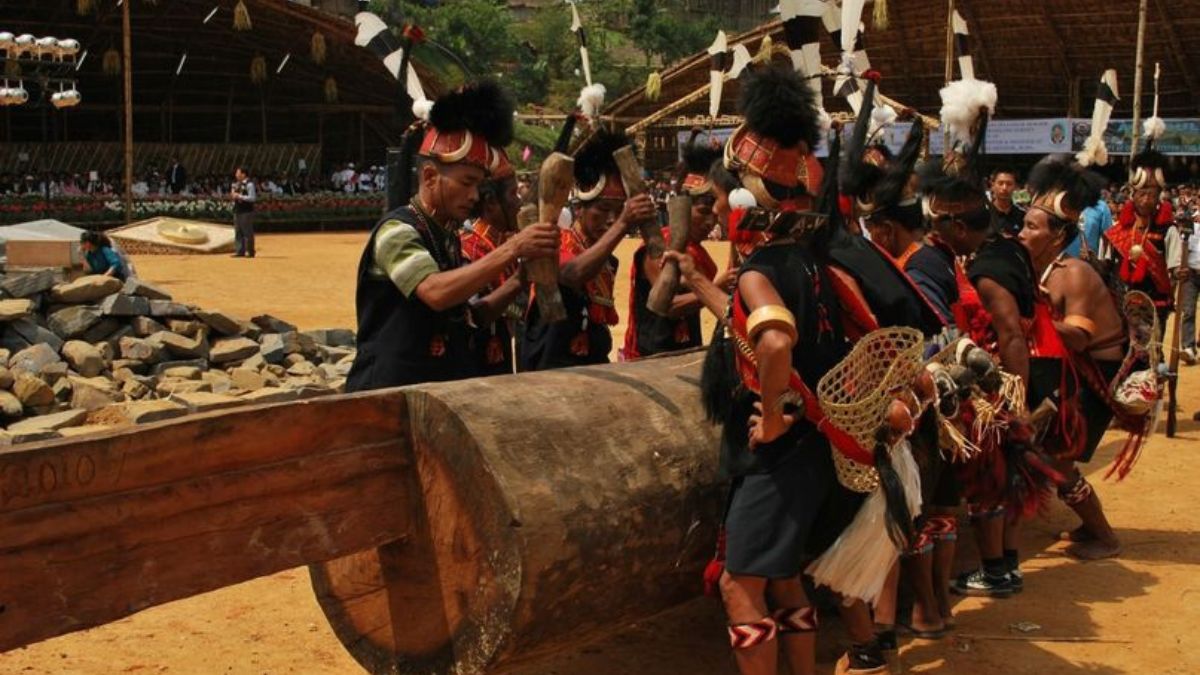The Naga Log Drum is more than just a musical instrument; it is a living embodiment of a vibrant and ancient culture. Its rhythms have resonated through the annals of history, carrying messages of joy, sorrow, and spiritual connection. They carry stories of bygone eras and uniting the people through their enchanting rhythms.
Tracing The Journey Of Log Drum
The Naga log drum is not only a musical instrument but also a symbol of the Naga people's journey and survival through warfare and challenges.
It stands as a monument, epitomizing their resilience and strength.Through the log drum's beats, the Nagas celebrate their victories,… pic.twitter.com/frO2PFMgT3
— nagalandtourism (@tourismdeptgon) October 25, 2023
The history of the Nagaland Log Drum dates back centuries, interwoven with the folklore and legends of the Naga tribes. The logs are hollowed out, typically using fire or a combination of fire and carving techniques and each is carefully selected to produce a distinct pitch. This process requires exceptional craftsmanship and skill, often passed down through generations.
The Log Drum’s significance in Naga culture extends far beyond its use as a musical instrument. Traditionally, these drums were employed to communicate across villages and even between different tribes. The rhythms played with great precision and conveyed messages about important events, communal gatherings, or emergencies. In this way, the log drum served as a unifying force.
The Naga Log Drum is a form of musical notation. Each drum carries a unique set of rhythms and tones, often understood only by the specific community or tribe that created it. The rhythms and patterns communicate information about the nature of the event, its significance, and even the time at which it will occur. In essence, the log drums served as a communal calendar, alerting the people to the events and rituals of daily life.
In the past two days, two videos from Nagaland have gone viral.
1st one is culture in its purest form – joyous images of young Konyak boys on a log drum – a tradition that goes back generations.
2nd is of DJ Rhon – a musician and DJ who exemplifies assimilation | cultural… pic.twitter.com/4ulSEKmwbX
— abu metha (@abumetha) April 7, 2023
For instance, the Konyaks see it as a female being with free will and desires. She chooses how many days it will take her to get to the village, and if she doesn’t want to, she won’t move an inch. The approval of the tree owner is equally important in determining how the log drum moves. After the construction of the log drum, it is then dragged using the ropes, rollers, and dowels.
ALso Read: Delhiites! Get A Slice Of Naga Life With Autumn Festival, Ahead Of Hornbill Festival In Delhi
Folklores And Beyond
Naga society is deeply rooted in culture, and the Log Drum plays a central role in their rituals and ceremonies. These drums are considered sacred and are often adorned with intricate carvings and designs. Even, each comes with its own spiritual significance. The drums are believed to connect the earthly realm with the spiritual world. Often serving as a conduit for communication with the gods and ancestors.
Every tribe has its own myths and beliefs about how to make and beat log drums. For example, the Konyaks’ wood drum, Kham, is linked to the legend surrounding their ancestry. The Nagaland Konyaks consider serving their elders and preserving the memories of their forefathers to be their primary responsibilities. They think that to cross a mysterious river and get to their current hamlet, their ancestors used canoes constructed out of single tree trunks. As a result, they craft a timber drum to resemble the tragic canoe that their ancestors used on this expedition. Depending on the needs of the village, a Konyak log drum might be carved every several decades.
The Largest Log Drum in the World, a Guiness Book of World records contender Aliba, Mokokchung,Nagaland, 16.06.2014 pic.twitter.com/q7pBnqXdvG
— Trekkers N Trotters (@TnTKol) December 16, 2015
Every tribe still uses log drums today, particularly to accompany festival acts, such as the well-known yearly Hornbill Festival. Have you seen this log drum yet?
Cover image credits: X/H. Khehovi
For more such snackable content, interesting discoveries and the latest updates on food, travel and experiences in your city, download the Curly Tales App. Download HERE.
Good news! We are on WhatsApp! Subscribe to Curly Tales WhatsApp Channel to stay up-to-date with exclusive content and BTS. Join HERE.
First Published: October 26, 2023 7:15 PM



